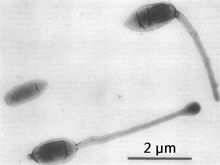The Hyphomicrobiaceae are a family of bacteria. Among others, they include Rhodomicrobium, a genus of purple bacteria.
| Hyphomicrobiaceae | |
|---|---|

| |
| Three representative cell types of a culture of Hyphomicrobium sp.. Note short processes on two of the three cells, thought to be remnants of the former mother hypha | |
| Scientific classification | |
| Domain: | |
| Phylum: | |
| Class: | |
| Order: | |
| Family: | Hyphomicrobiaceae Babudieri 1950
|
| Genera[3][4] | |
| |
| Synonyms | |
Phylogeny edit
The currently accepted taxonomy is based on the List of Prokaryotic names with Standing in Nomenclature (LPSN).[3] The phylogeny is based on whole-genome analysis.[4]
References edit
- ^ Takeuchi M, Katayama T, Yamagishi T, Hanada S, Tamaki H, Kamagata Y, Oshima K, Hattori M, Marumo K, Nedachi M, Maeda H, Suwa Y, Sakata S (2014). "Methyloceanibacter caenitepidi gen. nov., sp. nov., a facultatively methylotrophic bacterium isolated from marine sediments near a hydrothermal vent". Int J Syst Evol Microbiol. 64 (Pt 2): 462–468. doi:10.1099/ijs.0.053397-0. PMID 24096357.
- ^ Doronina NV, Poroshina MN, Kaparullina EN, Ezhov VA, Trotsenko YA (2013). "Methyloligella halotolerans gen. nov., sp. nov. and Methyloligella solikamskensis sp. nov., two non-pigmented halotolerant obligately methylotrophic bacteria isolated from the Ural saline environments". Syst Appl Microbiol. 36 (3): 148–154. doi:10.1016/j.syapm.2012.12.001. PMID 23351489.
- ^ a b Euzéby JP, Parte AC. "Hyphomicrobiaceae". List of Prokaryotic names with Standing in Nomenclature (LPSN). Retrieved 15 May 2021.
- ^ a b Hördt A, García López M, Meier-Kolthoff JP, Schleuning M, Weinhold LM, Tindall BJ, Gronow A, Kyrpides NC, Woyke T, Göker M (2020). "Analysis of 1,000+ Type-Strain Genomes Substantially Improves Taxonomic Classification of Alphaproteobacteria". Front. Microbiol. 11: 468. doi:10.3389/fmicb.2020.00468. PMC 7179689. PMID 32373076.
- ^ a b Yarza P, Yilmaz P, Pruesse E, Glöckner FO, Ludwig W, Schleifer KH, Whitman WB, Euzéby J, Amann R, Rosselló-Móra R (2014). "Uniting the classification of cultured and uncultured bacteria and archaea using 16S rRNA gene sequences". Nat Rev Microbiol. 12 (9): 635–45. doi:10.1038/nrmicro3330. hdl:10261/123763. PMID 25118885. S2CID 21895693.